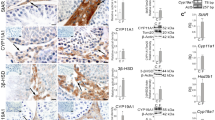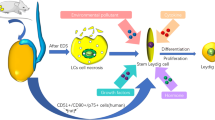Abstract
Purpose
Recent experimental evidence on non-mammalian animal models showed that d-Aspartic acid (d-Asp) administration increases testosterone levels through upregulation of StAR in Leydig cells. In this study, we aimed to investigate in vitro the signaling pathway associated with d-Asp stimulation in MA-10 murine Leydig cells.
Methods
MA-10 cells were stimulated with different concentrations of d-Asp, in presence or absence of hCG. Then total testosterone (T) levels in the culture medium were evaluated by electrochemiluminescence immunoassay, and StAR and LHR protein expressions were quantified by the means of Western blotting. LHR cellular localization after hormonal stimulation was assessed by immunofluorescence.
Results
Stimulation with the sole d-Asp did not induce any relevant increase of T release from cultured cells. On the other hand, stimulation with hCG induced significant increase of T (P = 0.045). Concomitant stimulation with hCG and d-Asp, at the concentration of 0.1 and 1 nM, induced additional and significant increase of released T (P = 0.03 and P = 0.04, respectively). StAR protein levels increased after concomitant stimulation with hCG and d-Asp 0.1 nM, compared with stimulation with the sole hCG (P = 0.02), whereas no variation in LHR protein expression was observed. Finally, d-Asp attenuated displacement of LHR staining, from cell membrane to cytoplasm, subsequent to hCG stimulation.
Conclusions
In this study, we confirmed a steroidogenic role for d-Asp, in concert with hCG, on murine Leydig cells, which is mediated by an increase in StAR protein levels. In addition, we showed that the possible mechanism subtending the effect of d-Asp could rely on the modulation of LHR exposure on the cell membrane.




Similar content being viewed by others
References
Hamase K, Morikawa A, Zaitsu K (2002) d-Amino acids in mammals and their diagnostic value. J Chromatogr B Analyt Technol Biomed Life Sci 781(1–2):73–91
Hamase K, Homma H, Takigawa Y, Fukushima T, Santa T, Imai K (1997) Regional distribution and postnatal changes of d-amino acids in rat brain. Biochim Biophys Acta 1334(2–3):214–222
Long Z, Homma H, Lee JA et al (1998) Biosynthesis of d-aspartate in mammalian cells. FEBS Lett 434:231–235
Long Z, Lee JA, Okamoto T, Nimura N, Imai K, Homma H (2000) d-Aspartate in a prolactin-secreting clonal strain of rat pituitary tumor cells (GH(3)). Biochem Biophys Res Commun 276:1143–1147
Sakai K, Homma H, Lee JA et al (1998) Localization of d-aspartic acid in elongate spermatids in rat testis. Arch Biochem Biophys 351(1):96–105
D’Aniello G, Ronsini S, Guida F, Spinelli P, D’Aniello A (2005) Occurrence of d-aspartic acid in human seminal plasma and spermatozoa: possible role in reproduction. Fertil Steril 84(5):1444–1449
Burrone L, Raucci F, Di Fiore MM (2012) Steroidogenic gene expression following d-aspartate treatment in frog testis. Gen Comp Endocrinol 175(1):109–117
Furuchi T, Suzuki T, Sekine M, Katane M, Homma H (2009) Apoptotic inducers activate the release of d-aspartate through a hypotonic stimulus-triggered mechanism in PC12 cells. Arch Biochem Biophys 490(2):118–128
Katane M, Homma H (2011) D-Aspartate–an important bioactive substance in mammals: a review from an analytical and biological point of view. J Chromatogr B Analyt Technol Biomed Life Sci 879(29):3108–3121
Cooke BA, Choi MC, Dirami G, Lopez-Ruiz MP, West AP (1992) Control of steroidogenesis in Leydig cells. J Steroid Biochem Mol Biol 43(5):445–449
Ascoli M (1981) Characterization of several clonal lines of cultured Leydig tumor cells: gonadotropin receptors and steroidogenic responses. Endocrinology 108:88–95
Clark BJ, Wells J, King SR, Stocco DM (1994) The purification, cloning, and expression of a novel luteinizing hormone-induced mitochondrial protein in MA-10 mouse Leydig tumor cells. Characterization of the steroidogenic acute regulatory protein (StAR). J Biol Chem 269:28314–28322
Nagata Y, Homma H, Matsumoto M, Imai K (1999) Stimulation of steroidogenic acute regulatory protein (StAR) gene expression by d-aspartate in rat Leydig cells. FEBS Lett 454:317–320
Furuchi T, Homma H (2005) Free d-aspartate in mammals. Biol Pharm Bull 28:1566–1570
Topo E, Soricelli A, D’Aniello A, Ronsini S, D’Aniello G (2009) The role and molecular mechanism of d-aspartic acid in the release and synthesis of LH and testosterone in humans and rats. Reprod Biol Endocrinol 7:120–130
Chandrashekar KN, Muralidhara (2008) Oxidative alterations induced by d-aspartic acid in prepubertal rat testis in vitro: a mechanistic study. Theriogenology 70(1):97–104
Tsuchiya M, Inoue K, Matsuda H et al (2003) Expression of steroidogenic acute regulatory protein (StAR) and LH receptor in MA-10 cells. Life Sci 73(22):2855–2863
Smrcka AV (2008) G protein βγ subunits: central mediators of G protein-coupled receptor signaling. Cell Mol Life Sci 65(14):2191–2214
Wang H, Segaloff DL, Ascoli M (1991) Lutropin/choriogonadotropin down-regulates its receptor by both receptor-mediated endocytosis and a cAMP-dependent reduction in receptor mRNA. J Biol Chem 266:780–785
Kanamarlapudi V, Thompson A, Kelly E, López Bernal A (2012) ARF6 activated by the LHCG receptor through the cytohesin family of guanine nucleotide exchange factors mediates the receptor internalization and signaling. J Biol Chem 287(24):20443–20455
Hirakawa T, Galet C, Ascoli M (2002) MA-10 cells transfected with the human lutropin/choriogonadotropin receptor (hLHR): a novel experimental paradigm to study the functional properties of the hLHR. Endocrinology 143(3):1026–1035
Zhang Y, Cudmore RH, Lin DT, Linden DJ, Huganir RL (2015) Visualization of NMDA receptor-dependent AMPA receptor synaptic plasticity in vivo. Nat Neurosci. doi:10.1038/nn.3936. [Epub ahead of print]
Santillo A, Falvo S, Chieffi P et al (2014) D-aspartate affects NMDA receptor-extracellular signal-regulated kinase pathway and upregulates androgen receptor expression in the rat testis. Theriogenology 81(5):744–751
D’Aniello A, Di Fiore MM, Fisher GH et al (2000) Occurrence of d-aspartic acid and N-methyl-d-aspartic acid in rat neuroendocrine tissues and their role in the modulation of luteinizing hormone and growth hormone release. FASEB J 14(5):699–714
Gore AC (2001) Gonadotropin-releasing hormone neurons, NMDA receptors, and their regulation by steroid hormones across the reproductive life cycle. Brain Res Rev 37(1–3):235–248
Morris RG, Steele RJ, Bell JE, Martin SJ (2013) N -methyl-d-aspartate receptors, learning and memory: chronic intraventricular infusion of the NMDA receptor antagonist d-AP5 interacts directly with the neural mechanisms of spatial learning. Eur J Neurosci 37(5):700–717
Author information
Authors and Affiliations
Corresponding author
Ethics declarations
Conflict of interest
The authors have no conflict of interests to be disclosed.
Ethical approval
This article does not contain any studies with human participants or animals performed by any of the authors.
Informed consent
For this type of study formal consent is not required.
Additional information
A. Di Nisio and L. De Toni have equally contributed to the manuscript.
Rights and permissions
About this article
Cite this article
Di Nisio, A., De Toni, L., Ferigo, M. et al. d-Aspartic acid stimulates steroidogenesis through the delay of LH receptor internalization in a mammalian Leydig cell line. J Endocrinol Invest 39, 207–213 (2016). https://doi.org/10.1007/s40618-015-0333-4
Received:
Accepted:
Published:
Issue Date:
DOI: https://doi.org/10.1007/s40618-015-0333-4




